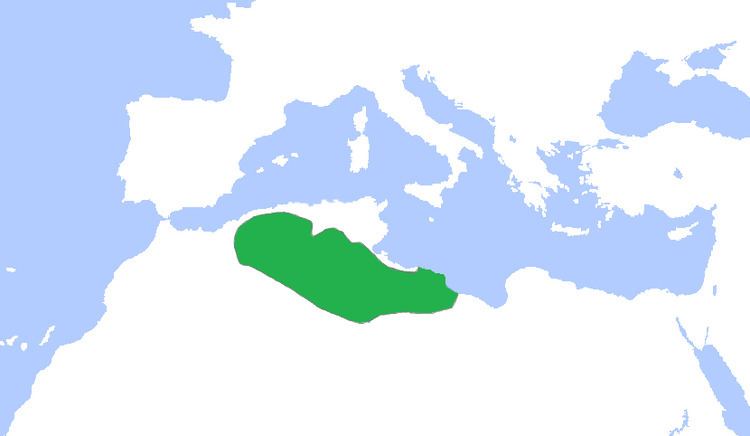Capital Tahert Government Imamate | Religion Khawarij | |
 | ||
Languages Berber, Arabic, Persian 776–788 ʿAbdu r-Rahman ibn Bahram ibn Rūstam 906–909 Yaqzan ibn Muhammad Abil-Yaqzan | ||
The Rustamids (or Rustumids, Rostemids) were a dynasty of Ibāḍī Khawarij imāms of Persian descent that ruled mostly in the central Maghreb as a Muslim theocracy for a century and a half from their capital Tiaret (in modern Algeria) until the Ismaili Fatimid Caliphate destroyed it. Their realm extended mostly to current central Algeria, but also Libya, Morocco and Mauritania.
Contents
History
The Ibāḍī movement reached North Africa by 719, when the missionary Salma ibn Sa'd was sent from the Ibādī jama'a of Basra to Kairouan. By 740, their efforts had converted the major Berber tribes of Huwara around Tripoli, in the Nafusa Mountains and at Zenata in western Tripolitania. In 757 (140 AH), a group of four Basra-educated missionaries including ʻAbd ar-Rahmān ibn Rustam proclaimed an Ibāḍī imamate, starting an abortive state led by Abu l-Khattab Abdul-A'la ibn as-Samh which lasted until the Abbasid Caliphate dispatched Muhammad ibn al-Ash'ath al-Khuza'i to suppress it in 761, and Abul-Khattab Abdul-A'la ibn as-Samh was killed. On his death, the Tripolitanian Ibādiyya elected Abu l-Hatim al-Malzuzi as Imām; he was killed in 772 after launching a second unsuccessful revolt in 768.
After this, the center of power shifted to Algeria, and, in 777, ʻAbd ar-Rahmān ibn Rustam, an Ifriqiyan-born convert to the Ibāḍī movement of Persian origin and one of the four founders of the imamate, was elected Imām; after this, the post remained in his family, a practice which the Ibādiyya justified by noting that he came from no tribe, and thus his family had no bias towards any of the tribes of which the state was formed.
The new imamate was centered on the newly built capital of Tiaret; several Ibādī tribes displaced from Tunisia and Tripolitania settled there and strong fortifications were built. It became a major stop on the newly developing trade routes with sub-Saharan Africa and the Middle East. It was described by visitors such as the Sunni historian Ibn al-Ṣaghīr as notably multi-religious, with a significant and loyal Christian minority and a substantial number of Sunnis and Jews, and open religious debate was encouraged.
Ibn as-Saghir also describes the Imām as ascetic, repairing his own house and refusing gifts; the citizens sharply criticized him if they considered him derelict in his duty. Religious ethics were strictly enforced by law.
The Rustamids fought the Kairouan-based Aghlabids of Ifriqiya in 812, but otherwise reached a modus vivendi; this displeased Ibādī tribes on the Aghlabid border, who launched a few rebellions.
After Abdu l-Wahhāb, the Rustamids grew militarily weak; they were easily conquered by the Ismaili Fatimids in 909, upon which many Ibāḍis – including the last Imām – fled to the Sedrata tribe of Ouargla, whence they would ultimately emigrate to Mzab.
The Rustamid dynasty, "developed a cosmopolitan reputation in which Christians, non-Kharijite Muslims, and adherents of different sects of Kharijism lived".
